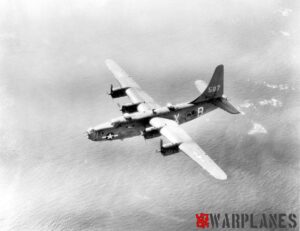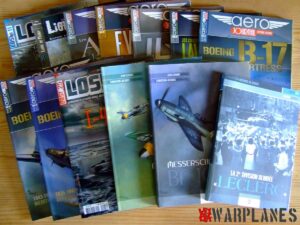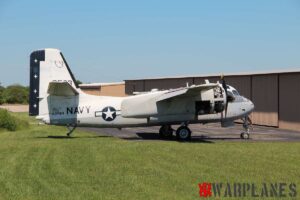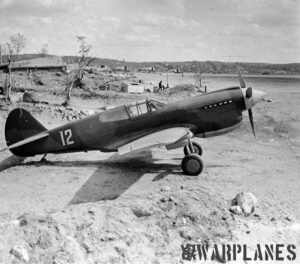German Strange Apparatus
Germany always was a leading nation in the development of aircraft types and in aerodynamic sciences. They had some very famous institutions and their scientific knowledge was always admired by the rest of the world! Also in Germany some aircraft designs were far from conventional as we shall see!
Photo 1

The Arado Ar-232 was a military transporter with as most important characteristic it could fly to simple unpaved fields in the front lines for direct supply of man and material. It was nicknamed as the ‘Tausendfüssler’ (centipede), although it only had a train of in total 11 pairs of small fully retractable wheels under the fuselage. It helped to land on even swampy terrains and with its rear loading ramp it was the Lockheed Hercules of its time! Another characteristic feature was its long pod-shaped rear fuselage with a double tailplane. The Ar-232 was one of the most versatile transport planes from the Second World War and it flew both as twin and four-engine version.
Photo 2
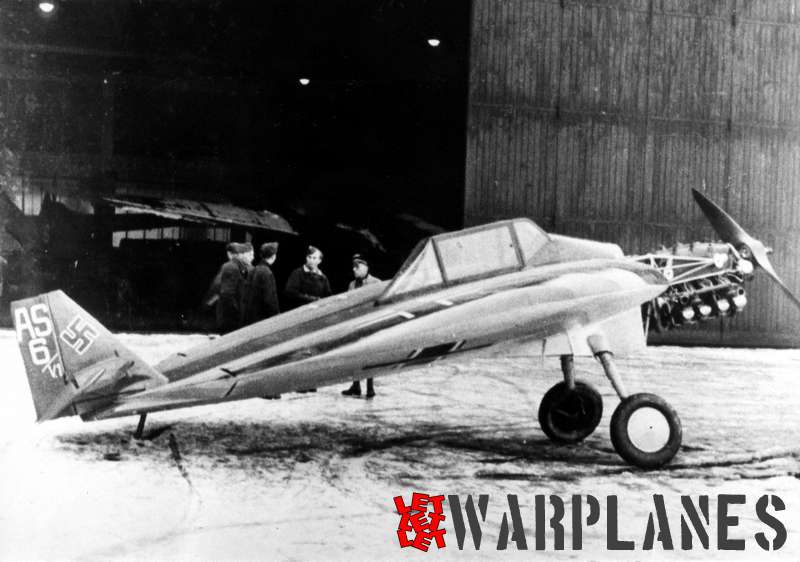
Arthur Sack was a talented model aircraft builder. In 1939 he had demonstrated a small powered disc shaped model plane powered by a small model engine. Although it had to be hand-launched, and although it flew erratic Sack continued his experiments with disc shaped wings. In early 1944 this resulted in the Model AS-6/V1, constructed by the Mitteldeutsche Motorwerke at Brandis near Berlin. It had a circular-section wing and a small fuselage with a conventional tail and to reduce costs and work parts from existing planes were used where possible. It was fitted with an Argus 10C-3 engine of 240 hp driving a two-bladed propeller in the noise. Although it made a few hops, it proved to be very unstable to fly. It was found left alone when JG400 fitted with Me-163 rocket fighters moved to Brandis. Some pilots tried to fly it, but they only managed to have the landing gear collapsed. The AS-6 was destroyed during an Allied air raid on Brandis. There are more rumours on German ‘Flying Saucer’ flight experiments, but at least the AS-6 is quite well documented!
Photo 3
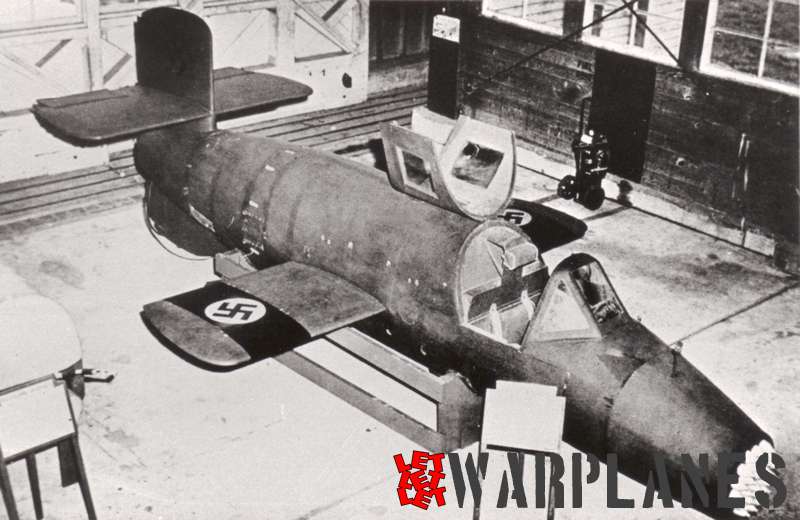
The Bachem Ba-349 Natter (adder) was quite unique in being the only manned anti aircraft missile ever built! It was built in two versions: as Ba-349A initial production version and as the improved Ba-349B with a larger tail and a more powerful rocket engine. It started in a vertical position from a special launching tower aided by four solid fuel booster rockets mounted at the rear fuselage. The Ba-349 was largely of wooden construction. The early tests took place with an unpowered version towed by a He-111 bomber. First unmanned powered flight was on 23 February 1945. In total 36 Ba-324A’s and 3 Ba-324B’s were built before the end of the war and they were never used operationally. The first manned launch took place a few days after the first unmanned launch. Soon after launch the canopy became detached and pilot Lothar Siebert was killed when it crashed. In total only a few launches were made. The Ba-349 was built as an answer to the large American daylight bomber formations. Once a formation was sighted, the Natter was launched. The pilot picked out a single bomber and fired 24 unguided rockets to the bomber in a single burst. Once the rockets were fired from the nose section of the Natter the little plane became uncontrollable and the pilot had to bail out by parachute after the nose section was released from the rest. The rear fuselage with the rocket engine was fitted with a parachute for re-use. The photo shows one of the captured Ba-349B Natters at Farnborough.
Photo 4
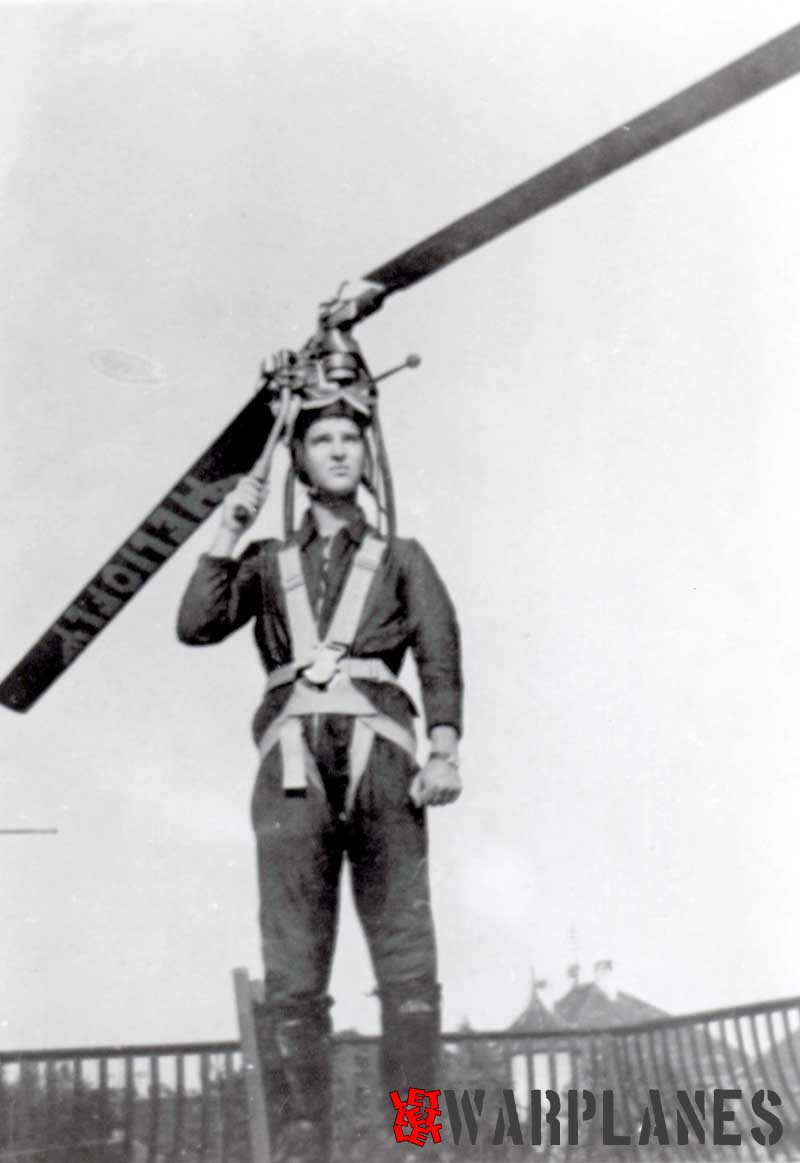
The Austrian engineer, Paul Baumgartl, designed during the Second World War small single-seat helicopters in the suburbs of Vienna. Baumgartl’s first product was the Heliofly I of 1941, which was little more than a strap-on autogyro glider for sporting use. It could be folded and carried in a backpack. For military use Baumgartl also developed a heaver powered version with a 16 hp engine but development was terminated before it was built.
Photo 5

The Berlin B-9 was a small twin-engine research aircraft for investigation of the prone pilot position where the pilot lay flat out on his belly on a specially designed cradle. It was built in 1937 for the Deutsche Versuchsanstalt für Luftfahrt ( German research institution for aeronautics) and powered by two 105 hp Hirth HM 500 engines. It was used for a number of years to provide date for the practicability of the prone position for dive bombers. One of the pilots flying the B-9 was Hans-Werner Lerche , who became later well known for flying a large number of captured Allied aircraft types.
Photo 6
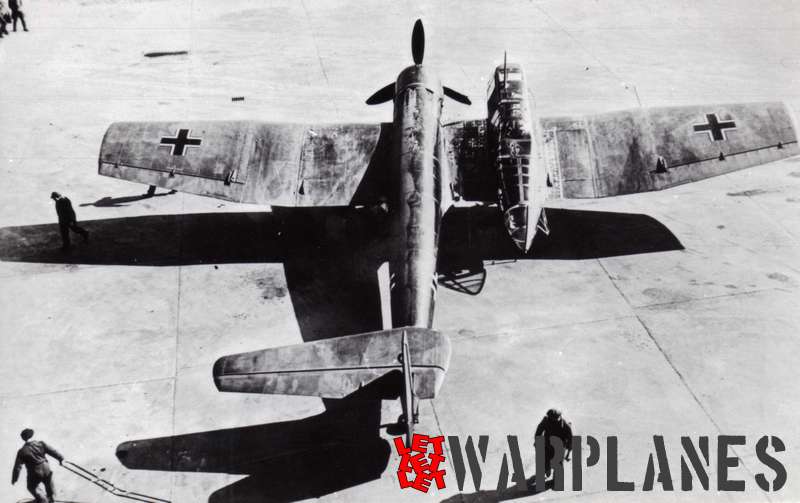
The Blohm und Voss BV-141 was developed in 1937 as a light bombing/ground attack and reconnaissance/utility plane with as most unorthodox feature its a-symmetrical layout of fuselage and cockpit section. This layout was selected to provide the crew the best possible all-round view and with fuselage and cockpit well separated the best chances of survival during a crash or emergency landing. In spite of its strange appearance it flew quit well and after three prototypes were built and flown Blohm und Voss received a small production order for an armed military version as the BV-141B. However, the B-version had less good performances that the prototypes and production was soon terminated. The photo shows the BV-141B no. V9.
Photo 7
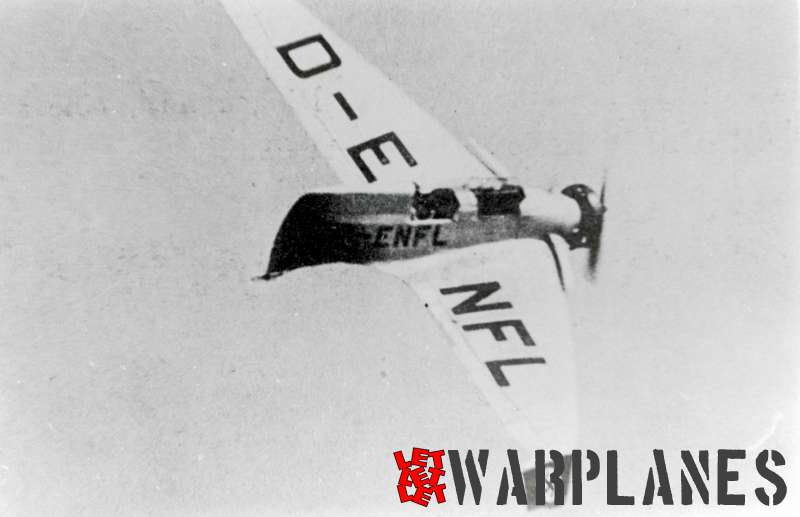
The DFS 39 Delta IVc carrying civil registration D-ENFL was a tailless experimental plane built and flown in 1936 by the Deutsche Forschungsinstitut für Segelflug DFS (German Investigations institution for glider flight). It was based on the ideas of dr. Alexander Lippisch. It was powered by a 75 hp British Pobjoy engine. The handling trials were so promising that it finally resulted in a rocket powered version that was the direct forerunner of the Messerschmitt Me-163!
Photo 8
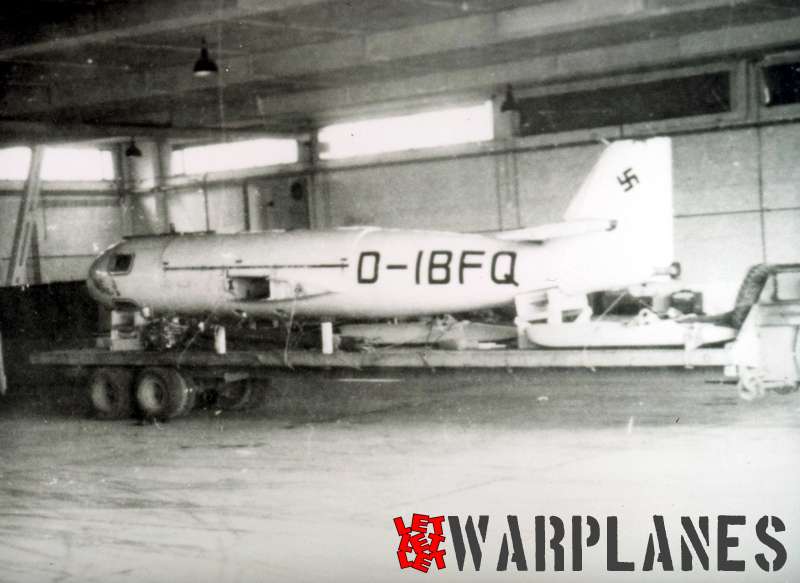
In 1940 the DFS started a very ambitious project for a rocket-powered high altitude glider that could be used for photo reconnaissance. It featured a sleek well streamlined fuselage with long glider-type wings. Known as the DFS 228 the first trials as a glider were made over 1943 and 1944. It was launched from the back of a Do-217K. However, it never made any rocket powered flights. With the use of its rocket engine service ceiling was calculated at some 22,000 m! The second prototype was never completed. The first prototype, carrying the civil registration D-IBFQ, was captured in derelict state with wings separated from the fuselage by U.S. forces in 1945 at Ainring. The photo shows the fuselage after its capture on a transport lorry. The DFS 228 can be regarded as a direct forerunner of the Lockheed U-2.
Photo 9
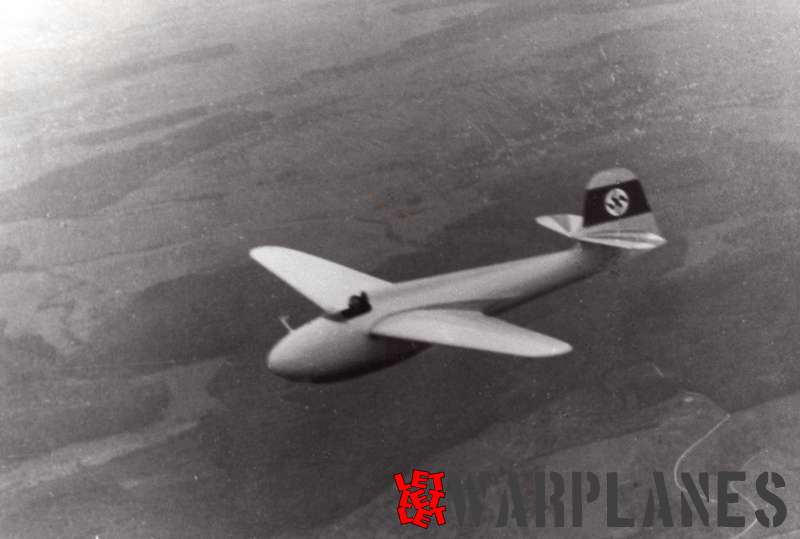
The DFS Habicht was a very popular singe-seat high performance glider in the years before the outbreak of the second world war. During the war it was used for military training. Future Messerschmitt Me-163 pilots exercised with the Habicht accurate spot landings. For this purpose the wings of the original Habicht were drastically shortened to give it the same landing speed of approx. 145 km/h as the Me-163. This version of the Habicht was known as the Stummel-Habicht.
(Collection Franz Selinger)
Photo 10
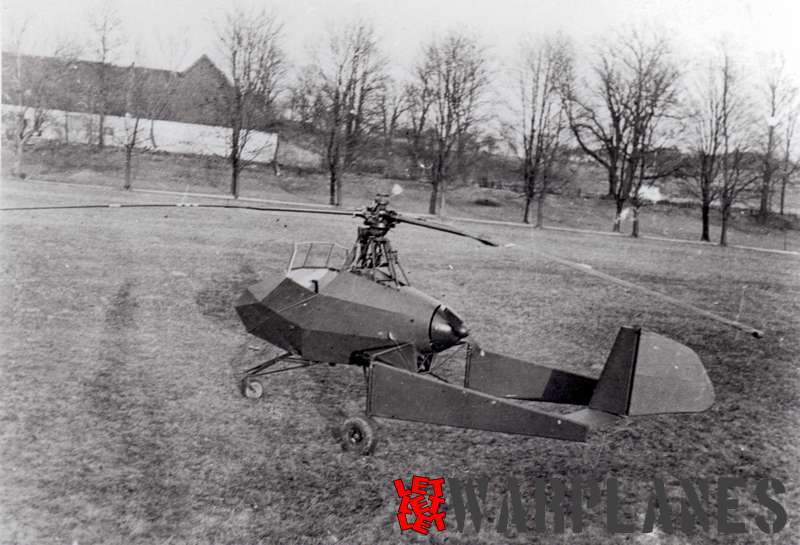
Pioneer of jet-tip drive for helicopters was the Austrian Dipl.-Ing. Friedrich von Doblhoff who started his experiments in 1941. In the Wiener Neustadt Fugzeugwerke WNF this resulted in the construction of a number of prototypes of which the last one, the WNF 342V4 was in its final test phase when the WNF works were captured by U.S. forces. The WNF 324V4 is still existing at the Smitsonian collection. Von Doblhoff was offered after the war a position at McDonnald Aircraft where he continued his jet-tip drive experiments with the experimental McDonnell XV-1 convertiplane
Photo 11

The Dornier Do-X twelve-engine flying boat was built over 1926-1927 at Altenrhein, Switzerland as the largest flying boat in the world. When it flew in 1929 it was also the largest aircraft of the world. The Do-X was built on an unlimited-fund contract and showed the world what German aeronautical engineers were capable of with the latest technology of that time. Although it made a much-published world trip it never was economical! In spite of this, another two were built for Italy. The Do-X ended in the Deutsches Museum at Berlin where it was destroyed by Allied bombing in 1945. The picture shows the Do-X during its world tour when it visited Schellingwoude (Amsterdam) in November 1930.
Photo 12

Designed as an experimental trans-ocean flying boat and ordered by the Deutsche Lufthansa, the Dornier Do-14 made its first flight on 10 August 1936 after a 5-year development phase. The all-metal Do-14 featured many unusual and innovative construction details. It was powered by two BMW VI engines buried in the fuselage centre, coupled by a two-speed gearbox and driving a single large-size three bladed pusher propeller mounted in a pylon on top of the wing. The propeller was driven by means of a large extension shaft. Also the cooling system was very unusual with the engine radiators buried into the upper surface of the wing. They were flush-fitted and hardly created any extra drag. In spite of its very modern layout, the cockpit was still open, although it would have been fully enclosed at later versions. During its extensive test period, the Do-14 was taken over by the rapid development in aeronautical engineering where engines were mounted in the front part of the wing using variable-pitch propellers. In fact, the Do-14 was already outdated when it flew and DLH soon lost interest in the project! Only one single Do-14 was manufactured and flown.
Photo 13
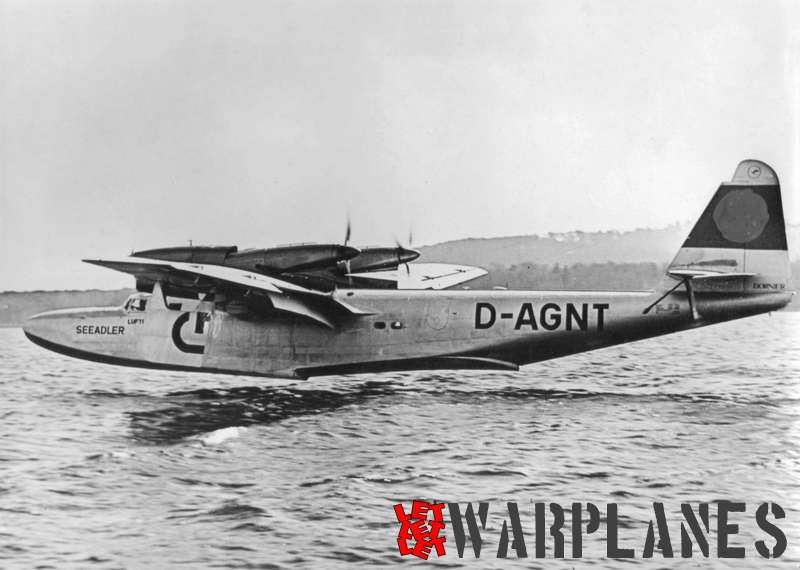
In 1937 the Deutsche Lufthansa (DLH) ordered six Dornier Do-26 four-engine flying boats for trans-ocean mail transport. It was a sleek-looking all-metal machine with a gull-type shoulder wing. The engines were mounted in two pairs in the wings driving tractor and pusher propellers. The pusher propellers were driven by a short extension shaft, which could be swivelled 10° upwards to clear the propellers of water spray during take-off and landing. The first Do-26, the Do-26V1, made its first flight on 21 May 1938. On this occasion it was flown by flight-captain Erich Gundermann. A this occasion it did not yet carry any registration. Later, it was put into service with the civil registration D-AGNT carrying the name Seeadler (sea eagle). Together with a small number of military Do-26’s they were used by the German navy during the Second World War. On this official post-war Dornier photo of the Do-26V1 D-AGNT the Swastika on the tail has been tactfully removed!
Photo 14
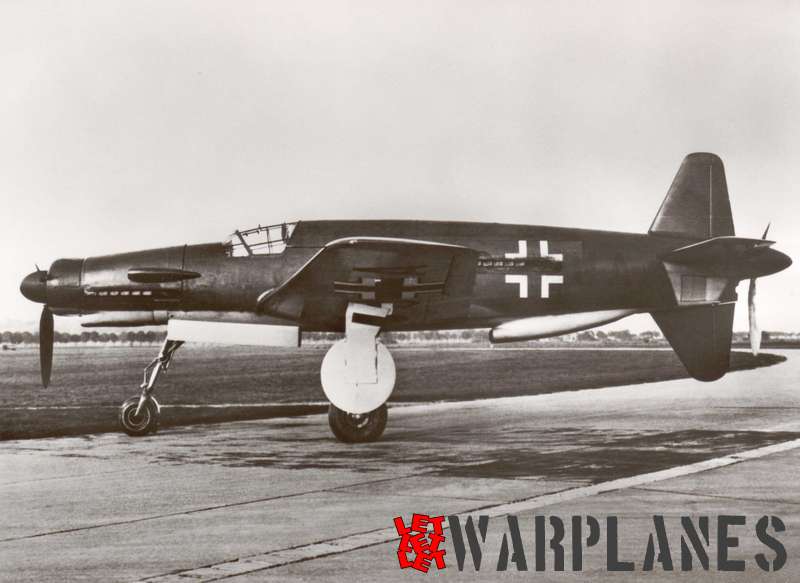
One of the most spectacular looking Luftwaffe fighters was undoubtedly the Dornier Do-335 Pfeil (arrow). It was a heavy fighter with two Daimler Benz DB 603 engines of 1750 hp each; one fitted in the nose and one in the tail driving a pusher propeller. This way of ‘center line thrust’ had many advantages over a normal twin engine layout with the engines fitted in the wings. The prototype flew for the first time in October 1943 and with its maximum speed of 732 km/h it was the fastest fighter the Luftwaffe had. However, series production started too late for large scale operational service and in total some 40 were built when Germany surrendered and not all of these were fully completed. The operational version was the Do-335A as pictured here, but Dornier also had a two-seat version with a raised second cockpit as the Do-335B. A number of Do-335’s were captured in Germany by Allied forces, including the two-seat version and some were test flown after the war. The Do-335 was one of the first aircraft fitted with an ejector seat.
Photo 15
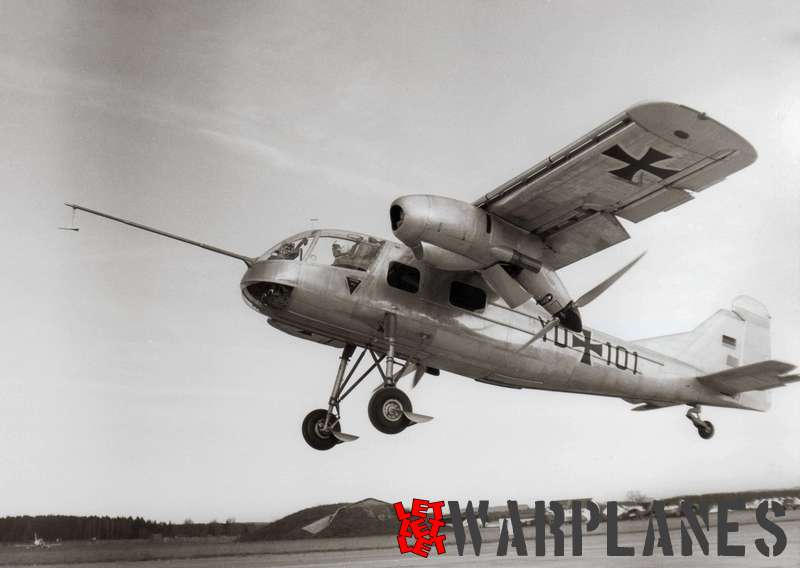
After the war Dornier started again with aircraft production with the quite successful Do-27.
Based on this Do-27 Dornier built a research vehicle for investigation of extreme STOL start and landing techniques as the Do-29. A standard Do-27 was used fitted with two underwing mounted Continental engines of 270 hp each. They drove pusher propellers that could be tilted downwards to give the propeller thrust an additional lift component for a very short take off and landing. Dornier built in total three of these research planes that were tested in the late fifties/early sixties. Although they provided valuable information it never resulted in an operational type.
Photo 16

The Dornier Do-31 was an attempt from Dornier for a VTOL jet transport plane with vertical thrust engines fitted in wing tip pods. To study the control of such a totally new type during hovering and very low speed, Dornier constructed one of the strangest looking flying devices ever built: the Dornier Do-31 Reglerversuchsgestell or ‘control investigation device’. It was a cruciform tubular construction fitted with four vertical mounted jet engines. It was flight tested in 1964. It was followed by a second research model, known as the Schwebegestell (hovering device) that was in fact already a primitive form of the final Do-31. The Do-31 program was terminated end 1969 after three Do-31 prototypes were built. In spite of the program’s cancellation the Do-31 flew well and established even a number of flight records. The direct reason for the Do-31 failure was the old and well-known problem of VTOL types with vertical lift engines: they were not economical because the lifting engines were nothing more than dead weight during normal forward flight!
Photo 17

Dr. Anton Flettner pioneered in the late thirties with the development of the first practical helicopter fitted with intermeshing rotor blades. Under the type designation Flettner Fl-265V1 and with civil registration D-EFLT a proof-of-concept model was flown successfully in 1939. On the photo we see it hovering during a demonstration for German officials. It was further developed into the Fl-282 Kolibri naval helicopter that only saw limited service during the war years.
Photo 18
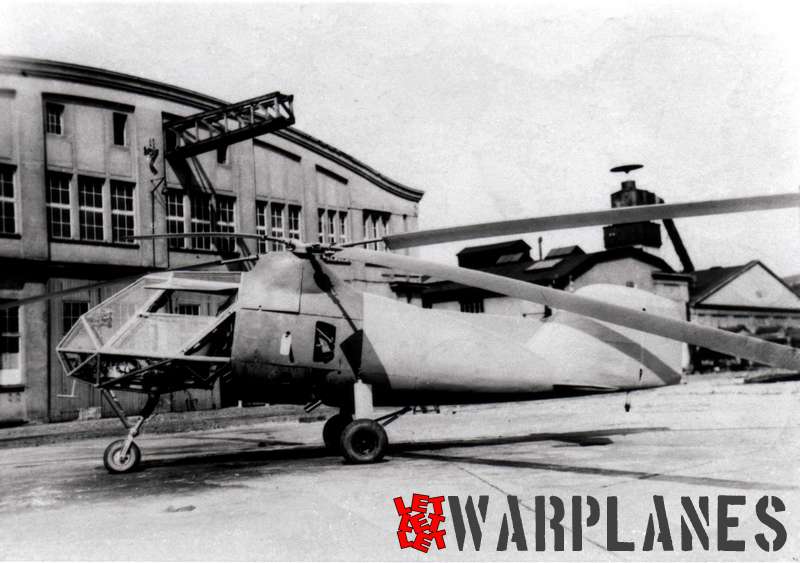
This was the final result of Flettner’s experiments: the Fl-282 small observation helicopter. It was built on a small scale only and on almost all versions the pilot flew it on an open seat. On the second machine, the Fl-282V2, a fully enclosed glazed cabin was used as we see pictured here. In total 24 were built. During operational trials it flew very well but a large order of 1000 was never realized because of Allied bombing of the production facilities.
Photo 19

The Focke-Achgelis FA-223 was German’s first practical transport helicopter. It was fitted with two rotors fitted on fuselage mounted outriggers. They were still under operational development by the end of the war in 1945 and only a small number was actually built. On the picture we can see the FA-223V12 with military markings DM # SP during military trials in 1943 at Ainring.
(Collection late Carl Bode)
Photo 20

The Focke Wulf works at Bremen constructed in 1927 a four-seat test plane with canard layout fitter with two Siemens-Halske radial engines of 110 hp each. Fitted with civil registration D-1960 it made a number of demonstration flights in various European countries. It was flown by DLV pilots until 1939. After its flying career it went to the Deutsches Museum in Berlin where it was destroyed in 1945 during aerial bombing. Only one was built and on this rare picture we see it at Schiphol airport with a camera team at the background.
(Collection late Piet Kok)
Photo 21
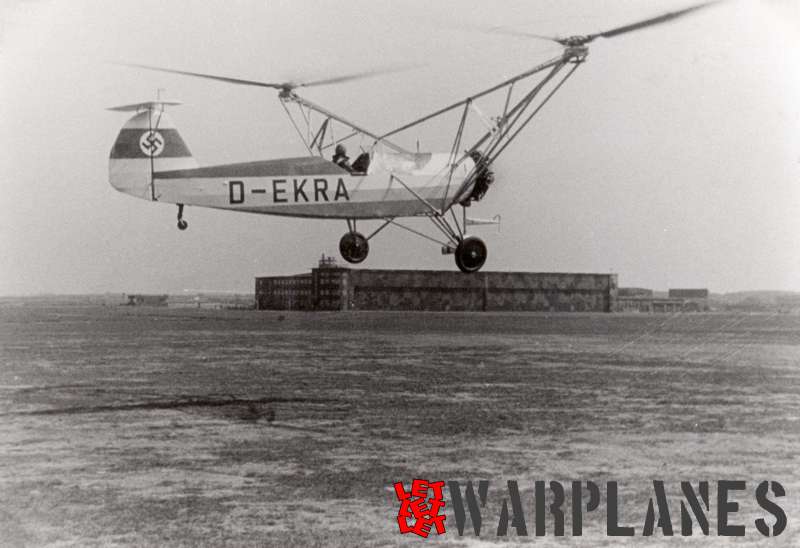
The Focke Wulf FW-61 was a single seat test helicopter that flew record flights in the years before the war. In fact it was the proof-of-concept model for the later FA-223 transport helicopter! One of the pilots flying the FW-61 was Hannah Reitsch. This rare picture from the private collection of helicopter test pilot Carl Bode shows D-EKRA, the second prototype with Carl Bode in the cockpit. Bode also made flight tests with D-EKRA inside the large Deutschlandhalle at Berlin but this resulted in a crash because of unexpected air turbulences inside the hall. D-EKRA ended during this flight upside down on the ground and there are photos existing and published of a shaken Carl Bode crawling out of the wreckage.
(Collection late Carl Bode)
Photo 22
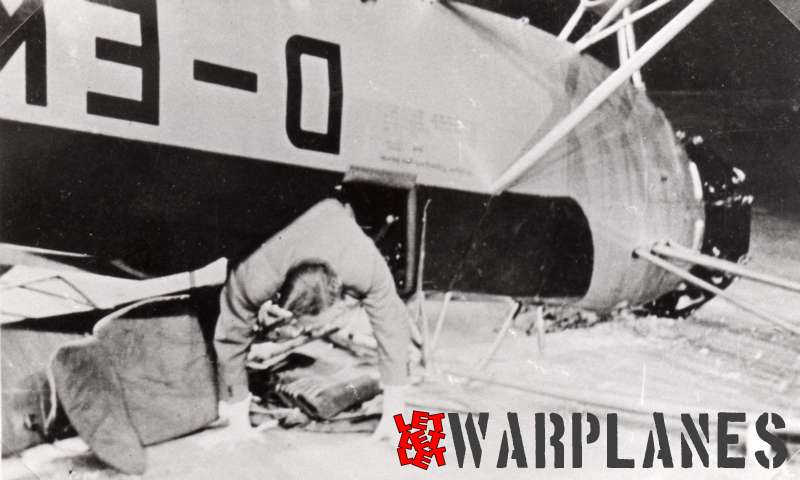
This shot is one of a series showing the crash of Carl Bode with the FW-61V2 D-EKRA in the Deutschlandhalle. We see Bode crawling out from the inverted wreck. The photos were taken by Ernst Udet using a small Robot 35 mm photo camera with motor transport (yes, even then! It was powered by a spring that had to be wound up by hand).
(Collection late Carl Bode)
Photo 23
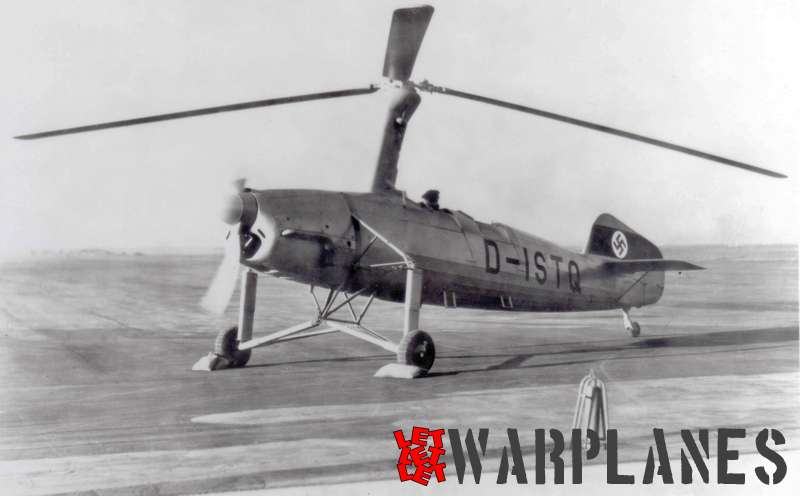
Based on earlier licence manufactured Cierva autogiro models, Focke-Wulf built in 1938 a more modern version fitted with a 240 hp Argus As 10 engine under type designation FW-186. The FW-186V1 carried the civil registration D-ISTQ. Flight tests were started in 1938 but the type was difficult to fly because of very high stick forces and the project was soon ended.
Photo 24
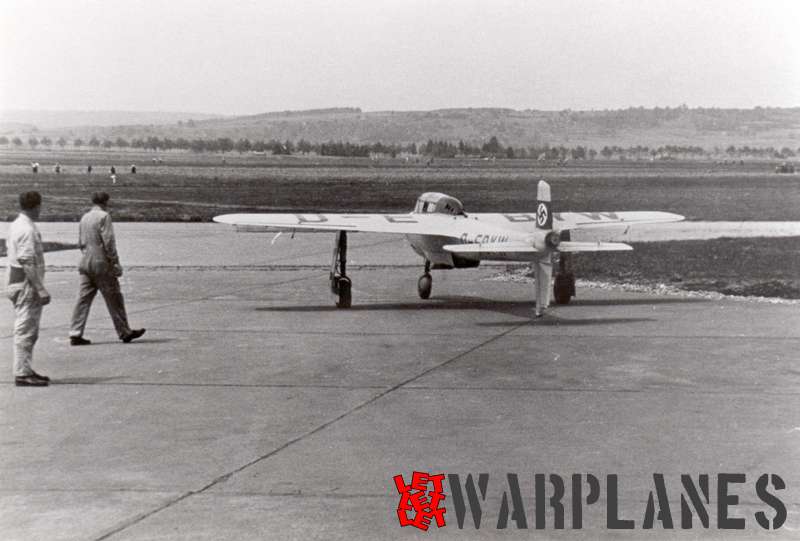
The Göppingen Gö-9 was a small research plane fitted with a pusher propeller that was designed to obtain in-flight data for the later Dornier Do-335 fighter. It was flown by Flugkapitän Quenzler in 1941 from Mengen airfield carrying the civil registration D-EBYW.
The picture shows test pilot Quenzel taxiing to the airstrip at Mengen.
(Collection Franz Selinger)
Photo 25
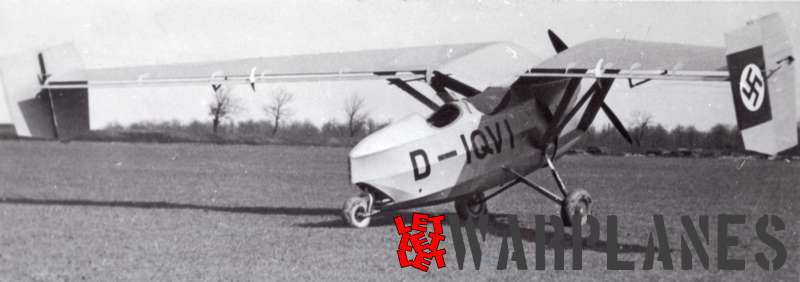
The Gotha Go-147 was a prototype for a small reconnaissance and liaison/communications aircraft constructed in 1936 by the Gothaer Waggonfabrik and Albert Kalkert. It was built to test how an aircraft without a tail would fly, with the hope of using the experience to produce a future version for military use. Further development was ended after the prototype D-IQVI proved to have poor flight characteristics and only one was built.
Photo 26
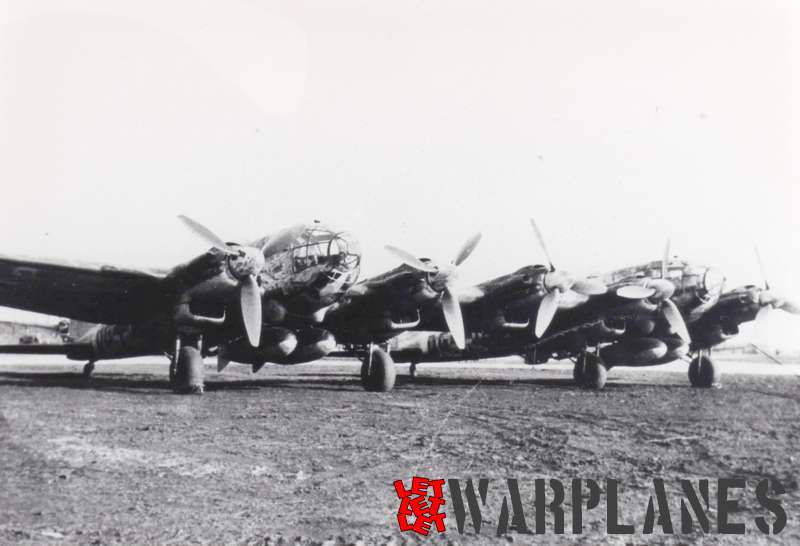
For aero-towing of the giant Messerschmitt Me-321 Gigant transport glider a special version of the well-known Heinkel He-111 bomber was used. Two He-111’s were joined together with a central wing section housing an extra engine. It was appropriately designated as He-111Z where ‘Z’ stood for Zwilling or Twin. The five engine combination was produced over 1942 and in total ten were built and used operationally. They not only served to tow Me-321 cargo gliders, but also the smaller Gotha Go-242. The He-111Z had a crew of seven.
Photo 27

The first purposely built manned rocket powered plane of the world was the Heinkel He-176.
Its first historical flight was made in deep secret on 20 June 1939. Heinkel published after the war a very nice artist impression of this He-178, made by the German aviation artist G.W. Heumann. In fact the He-178 illustrated by Heumann was a more developed version with a fully glazed cockpit canopy and a retractable undercarriage that was never built. The original He-178 was a much more primitive device with an open cockpit and a fixed undercarriage with a streamlined nosewheel! Of the original He-178 no official photographs seem to exist.
Photo 28
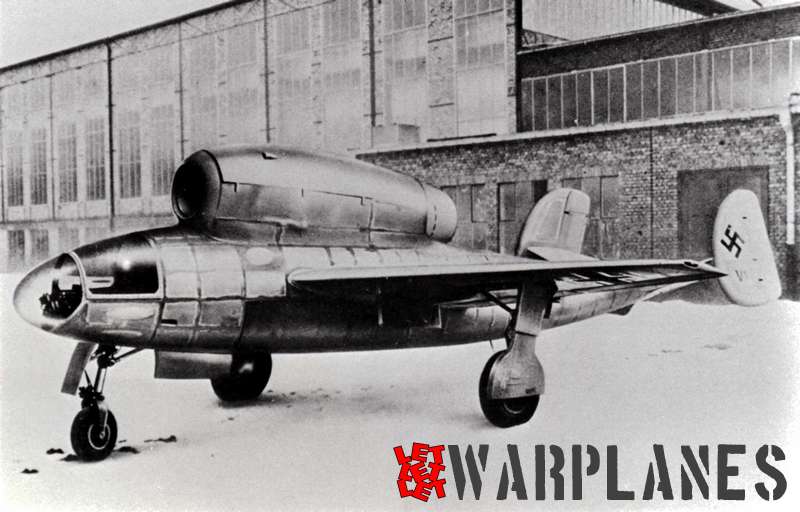
This very nice photo taken at the Henschel works shows the Hs-126V1 jet-powered dive bomber with the pilot in prone position. At least, that seems what we see! In reality fuselage and wings of the Hs-126 prototype were never mated and it never flew. The photo is a very clever ‘composition’ made in the photo laboratory!! The incomplete Hs-126V1 was captured in 1945 by Russian troops.
Photo 29
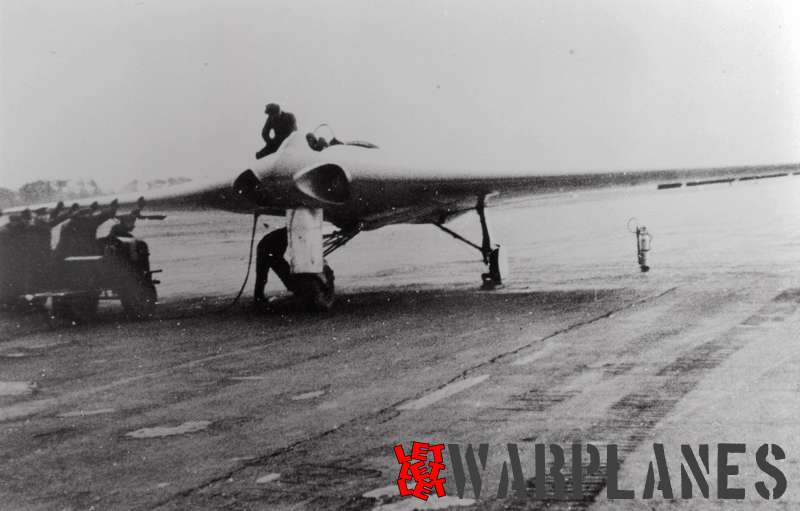
The Horten Ho-IXV2 was a jet powered flying wing that crashed on its first flight. The first prototype Ho-IXV1 was an unpowered glider version of this very modern looking experimental Luftwaffe fighter. The third prototype Ho-IXV3 was captured after the capitulation of Germany by U.S. forces and transported to the U.S.A. It is currently under restoration. There was already a dual seat prototype under construction when the war ended. Series production was planned at the Gothaer works as Go-229, but this never materialized.
Photo 30

Junkers already started in 1924 with a project for a large flying wing passenger plane as the Junkers J1000. It was never built, but its wing design was later used for the large Junkers G.38.
Photo 31
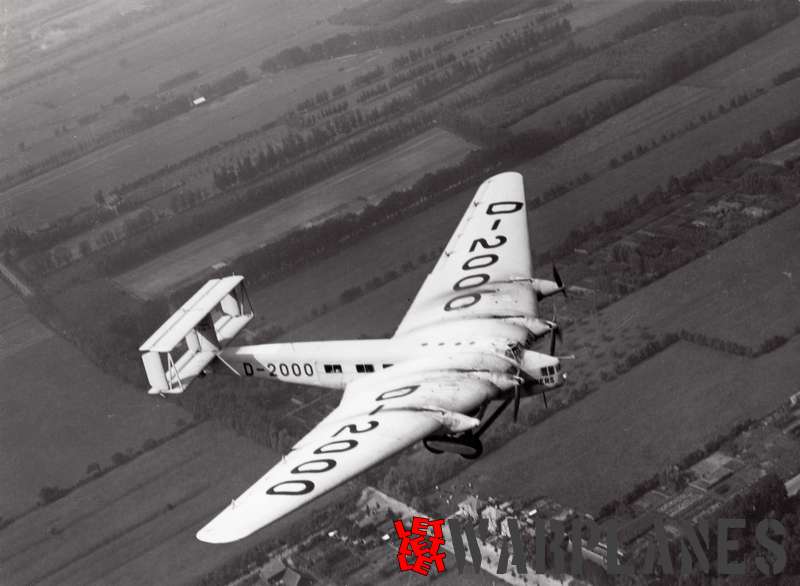
This is the G.38 as mentioned in the previous text. Two were built and operated by DLH as D-2000 and D-2500 (later as D-APIS and D-AZUR) before the war and even during the war it was used for troop transport. The in-flight picture shows the G.38 D-2000 flying near Schiphol airport
Photo 32

The Ju-287 was a very unusual jet bomber with forward-swept wings. The first prototype Ju-287V1 made its first flight in August 1944 fitted with a fixed undercarriage. The second prototype with a fully retractable undercarriage was almost completed when it was captured by Soviet forces. It must have been completed and flown in the Soviet Union after the war!
Photo 33
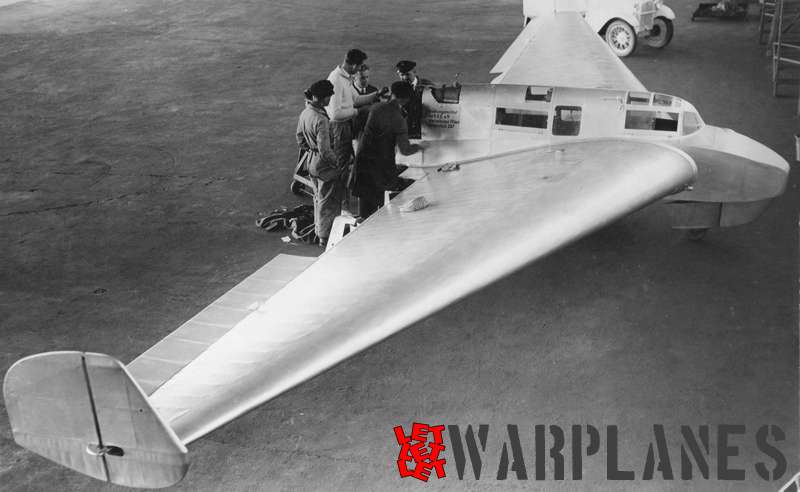
Built on order of the well known trans-ocean pilot Köhl a small tailless aircraft designed by dr. Alexander Loppish was built by the Rhön-Rositen-Gesellschaft at the famous Wasserkuppe glider centre. It was known as the Delta 1 and fitted with a British 30 hp Bristol Cherub engine. Köhl flew the Delta 1 in September 1931 from the Wasserkuppe to the airfield of Tempelhof in Berlin. The rare picture shows the Delta 1 after its landing at Tempelhof.
Photo 34

Lippisch continued his work on tailless aircraft during the war years resulting in a design for a small jet powered interceptor with delta wings; the P.13a. Powered by a coal-gas burning ramjet engine it had a planned supersonic maximum speed of some 1600 km/h. The P.13a was never built, but a piloted glider version with the same configuration known as the DM-1 was about to start its first flight tests launched from the back of a Siebel Si-204 when the war ended. It was captured by U.S. troops, crated and transported to the U.S.A. (together with dr. Lippisch, who was offered a job at Consolidated-Vultee Aircraft) where it was tested in the wind tunnel at Langley. The experiences of the DM-1 were used for the first experimental U.S. delta jet, the XF-92A. The NACA photo shows the DM-1 after its capture in Germany before it was crated.
Photo 35
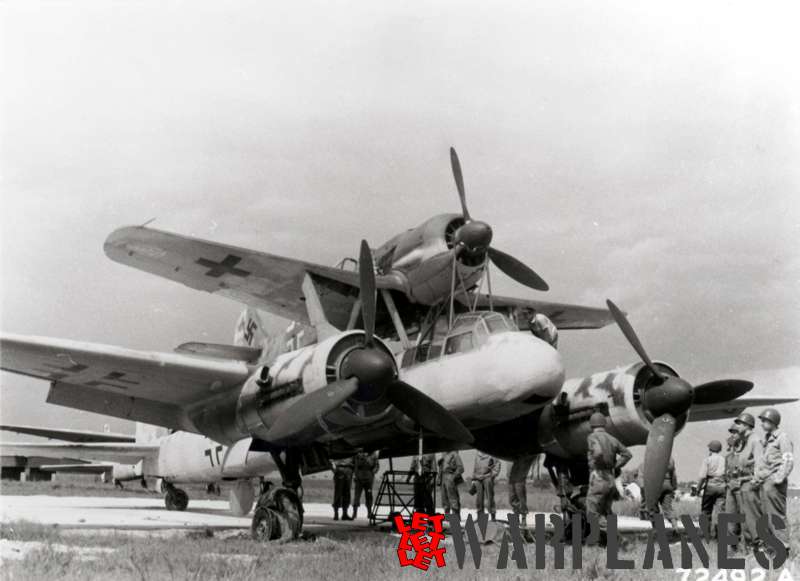
The German Luftwaffe used in the last phase of the war a quite desperate weapon: an unmanned twin engine bomber filled with explosives flown from a single engine fighter fitted on its back. The Germans called this combination a Mistel (mistletoe) and used it for attack of strategic Allied points. It was, however, used on a very small scale only and some of these strange Mistel combinations were captured by the end of the war by Allied forces. The picture shows the Mistel S3C with American soldiers. It was a Junkers Ju-88G-10 with fitted on top a Focke-Wulf FW-190F-8. After the war the same Mistel combination was shown in the U.K. on an exhibition of German captured aircraft, but in fact this combination was purposely made in the U.K for the exhibition only using a captured Ju-88 and FW-190!
Photo 36
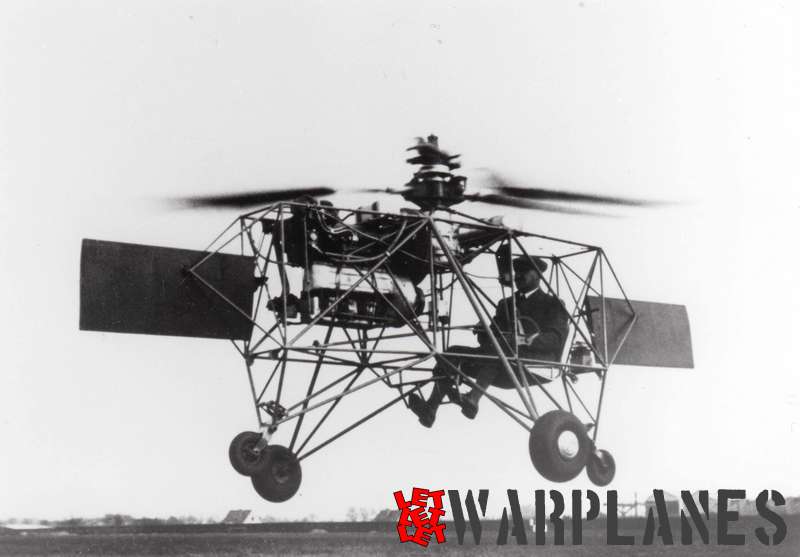
Walter Rieseler founded in the thirties a small company where he designed and developed a practical helicopter. It was know as the Rieseler R-1. It made its first flight in the summer of 1936 and was later shown to Ernst Udet, but unfortunately it crashed while hovering at very low altitude and Udet was not very impressed. In general the Rieseler R-1 behaved quite well and making vertical starts and landings were no real problem. The R-1 had a double coaxial rotor and was fitted with a Hirth HM504 engine of 85 hp. The R-1 was later rebuilt but the sudden death of Walter Riesler in May 1937 brought an end to all activities. The R-1 was on all occasions flown by test pilot Johannes Mohn.
Photo 37
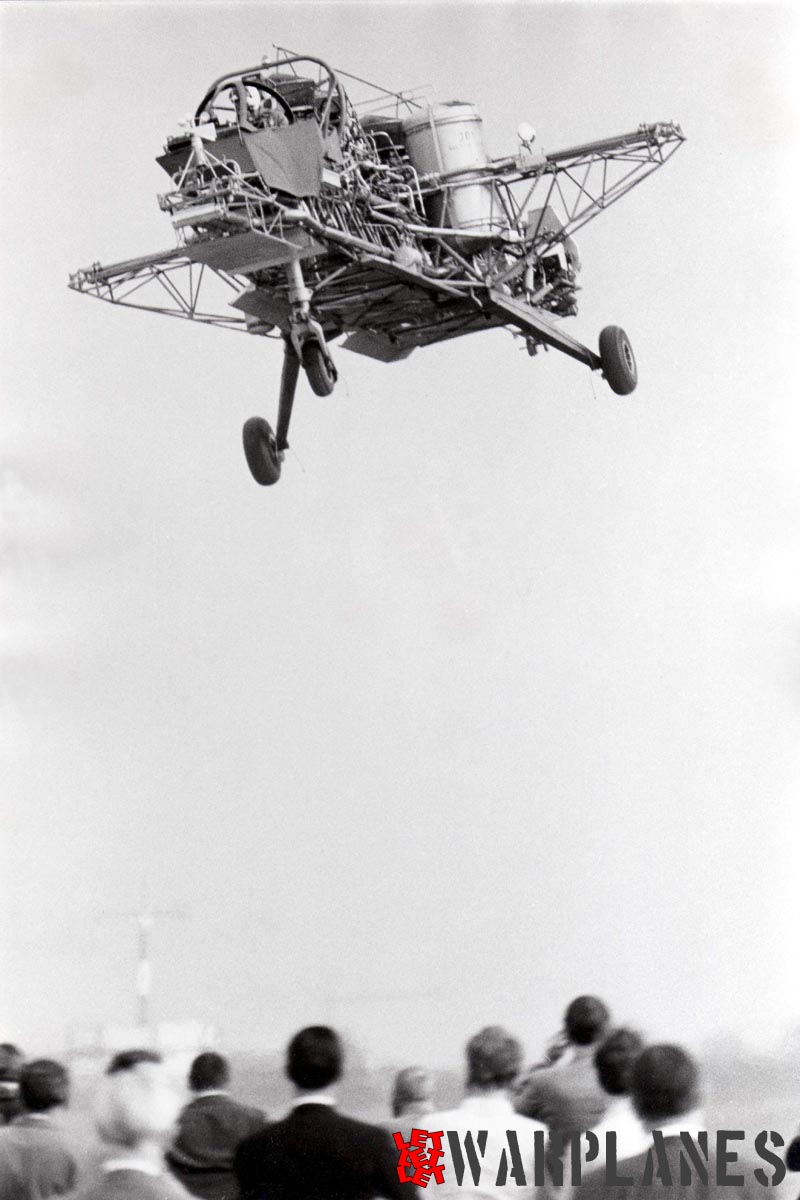
At the former Focke Wulf plant at Bremen, VFW constructed in the early sixties a very strange looking device for investigation of V/STOL flight. It was known as the VFW SG-1262 Schwebegestell (hovering device) and made its first flight in 1966. It was test-flown over a 3-years period and made in total some 200 flights. The results were used for the control systems of the VAK-191B and VJ101 VTOL fighters and for the Dornier Do-31 VTOL transporter.
This ‘plane’ is still existing at theWehrtechnische Studiensammlung at Koblenz. It was powered by five Rolls-Royce RB108 vertical lift engines, could reach a forwards speed of 75 km/h and had a flight duration of 12 minutes.
Nico Braas

